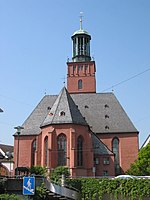New Synagogue (Darmstadt)

The Neue Synagoge ("New Synagogue") is the synagogue, community centre, and museum of the Jewish community (German: Jüdische Gemeinde) in Darmstadt. Inaugurated on in 1988, the synagogue was built as part of a citizens’ initiative to commemorate the 50th anniversary of Kristallnacht Known also as the ‘Holocaust Memorial Synagogue’, the architectural complex was designed to fulfil the needs of the city's Jewish population, who had been without a place of worship since the 1938 pogrom when Darmstadt's three synagogues were destroyed. Built according to plans by Alfred Jacoby, with a significant programme of stained glass windows designed by British architectural artist Brian Clarke. The religious and cultural complex is located on the site of the city's former Gestapo headquarters.
Excerpt from the Wikipedia article New Synagogue (Darmstadt) (License: CC BY-SA 3.0, Authors, Images).New Synagogue (Darmstadt)
Wilhelm-Glässing-Straße, Darmstadt Darmstadt-Mitte (Darmstadt-Mitte)
Geographical coordinates (GPS) Address Website Nearby Places Show on map
Geographical coordinates (GPS)
| Latitude | Longitude |
|---|---|
| N 49.8675 ° | E 8.65467 ° |
Address
Jüdische Gemeinde Darmstadt
Wilhelm-Glässing-Straße 24-30
64283 Darmstadt, Darmstadt-Mitte (Darmstadt-Mitte)
Hesse, Germany
Open on Google Maps









